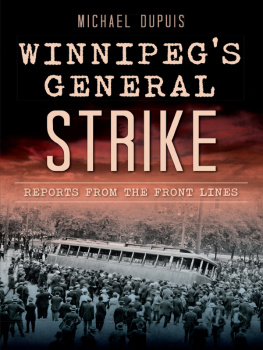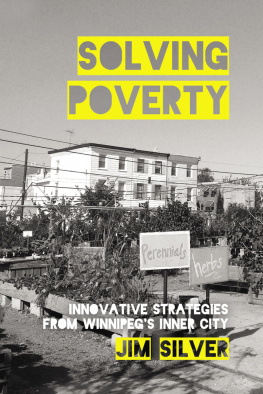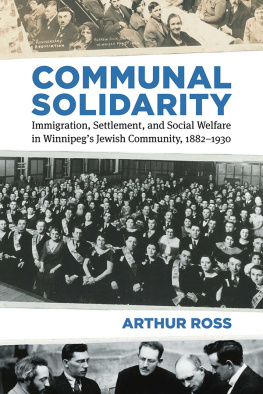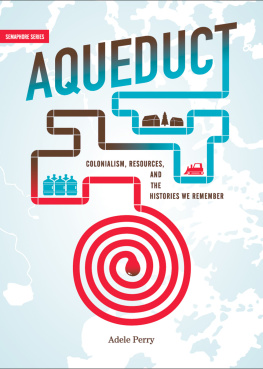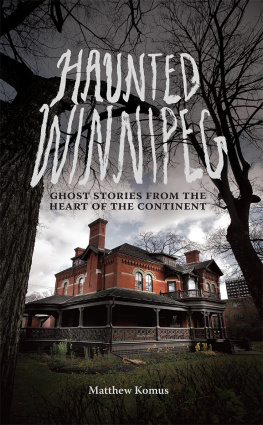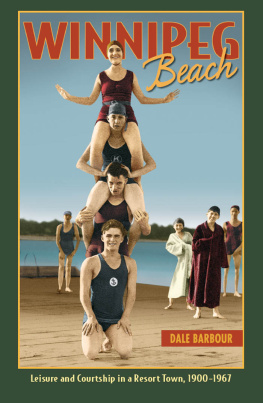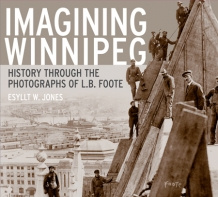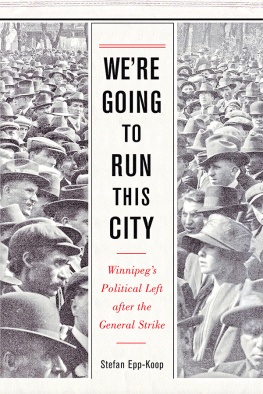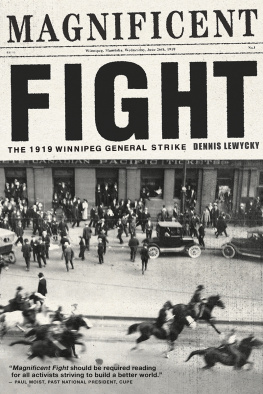THE PATRIOTIC CONSENSUS
Unity, Morale, and the Second World War in Winnipeg
JODY PERRUN
University of Manitoba Press
Winnipeg, Manitoba
Canada R3T 2M5
uofmpress.ca
Jody Perrun 2014
Printed in Canada
18 17 16 15 14 1 2 3 4 5
All rights reserved. No part of this publication may be reproduced or transmitted in any form or by any means, or stored in a database and retrieval system in Canada, without the prior written permission of the University of Manitoba Press, or, in the case of photocopying or any other reprographic copying, a licence from Access Copyright (Canadian Copyright Licensing Agency). For an Access Copyright licence, visit www.accesscopyright.ca, or call 1-800-893-5777.
Cover design: Frank Reimer
Interior design: Karen Armstrong Graphic Design
Library and Archives Canada Cataloguing in Publication
Perrun, Jody, 1971, author
The patriotic consensus : unity, morale, and the Second World War in Winnipeg / Jody Perrun.
Includes bibliographical references and index.
Issued in print and electronic formats.
ISBN 978-0-88755-749-1 (pbk.)
ISBN 978-0-88755-462-9 (PDF e-book)
ISBN 978-0-88755-464-3 (epub)
1. World War, 1939-1945ManitobaWinnipeg. 2. World War, 1939-1945Social aspectsManitobaWinnipeg. 3. Community lifeManitobaWinnipegHistory20th century. 4. Winnipeg (Man.) Social conditions20th century. I. Title.
FC3396.4.P47 2014 971.274302 C2014-903285-4 C2014-903286-2
This research was based in part on source materials accessed through the courtesy of the Government of Manitoba. The views, opinions, and conclusions contained in this work are those of the author, and have not been endorsed or approved by the Government of Manitoba.
The University of Manitoba Press gratefully acknowledges the financial support for its publication program provided by the Government of Canada through the Canada Book Fund, the Canada Council for the Arts, the Manitoba Department of Culture, Heritage, Tourism, the Manitoba Arts Council, and the Manitoba Book Publishing Tax Credit.
To Emily and Elise, my little ones, for whom I have such high hopes...
CONTENTS
LIST OF ILLUSTRATIONS
Figure 1.1. Winnipeg Grenadiers Parade on Memorial Avenue, 8 October 1939. Archives of Manitoba (AM), John E. Parker Collection, 19.
Figure 1.2. British Commonwealth Air Training Plan training over Fort Rouge. AM, Gingras Collection, 115.
Figure 1.3. Queens Own Cameron Highlanders Depart for Training, 24 May 1940. AM, Government Records, 27.
Figure 1.4. Eatons Decorated for VE-Day, AM, Eatons, 58.
Figure 3.1. To Have and to Hold! Bank of Canada Archives (BCA), BCP 305-436.
Figure 3.2. Save to Beat the Devil! BCA, BCP 305-434.
Figure 3.3. All Canada is United. Library and Archives Canada (LAC), HG 5155 02, 1941, xxfol. reserve.
Figure 3.4. Help Finish the Job. BCA, BCP 305-455.
Figure 3.5. Some Chicken... Some Neck! Winnipeg Free Press, 19 February 1942.
Figure 3.6. Mr. Churchill Himself University of Manitoba Archives and Special Collections (UMA), Winnipeg Tribune Collection, 2 March 1942.
Figure 3.7. Keep These Hands Off! LAC, 1983-30-230.
Figure 3.8. Youll Have to Do the Signing, Mister LAC, HG 5155 02, 1945, xxfol. reserve.
Figure 3.9. Choose Your Bonds Canadian War Museum, Beaverbrook Collection, 19920108-012.
Figure 3.10. For Victory. BCA, BCP 305-441.
Figure 3.11. Canada Got it First! BCA, BCP 305-453.
Figure 3.12. Im Dreaming of a modern kitchen ... ! LAC, HG 5155 02, 1945, xxfol. reserve.
Figure 3.13. Blackout Instructions. Winnipeg Free Press, 3 June 1941.
Figure 3.14. It Cant Happen Here. Manitoba Legislative Library, Vertical file, World War II, Manitoba.
Figure 3.15. If Day, 19 February 1942. Raising the Swastika at Lower Fort Garry. Winnipeg Free Press.
Figure 3.16. If Day, 19 February 1942. Premier Bracken and Cabinet Ministers Interned at Lower Fort Garry. Winnipeg Free Press.
Figure 3.17. If Day, 19 February 1942. Burning Books Outside the Carnegie Library. Winnipeg Free Press.
Figure 3.18. If Day, 19 February 1942. Nazis Parade Down Adolf Hitler Strasse (Portage Avenue). Winnipeg Free Press.
Figure 3.19. 7th Victory Loan Pageant, 21 October 1944. AM, CAPC, 255.
Figure 3.20. 8th Victory Loan Noon-gun Ceremony, 7 May 1945. AM, L.B. Foote Collection, 2361.
Figure 4.1. Red Cross Workers Packing Magazines. AM, CAPC, 293.
Figure 4.2. Clothing Drive for Russian Relief. Winnipeg Free Press, April 1944.
Figure 4.3. V-Bundles Newsletter. AM, P664, Social Planning Council of Winnipeg, file 10.
Figure 4.4. The Scrapper, Patriotic Salvage Corps newsletter. AM, P664, Social Planning Council of Winnipeg, file 10.
Figure 4.5. Patriotic Salvage Corps. Winnipeg Free Press, April 1942.
Figure 4.6. Winnipeg Ukrainians Hold a War Savings Concert, 19 October 1940. Winnipeg Free Press.
INTRODUCTION
At 1:18 a.m., on the morning of 1 September 1939, the first news despatches arrived in Winnipeg, announcing the German bombing of Polish cities. Residents of Warsaw, six hours ahead, awoke to the sound of air raid sirens. A crowd numbering in the hundreds held a night-long vigil in front of the Winnipeg Free Press building, where the bulletin boards delivered the latest updates. A thunderstorm broke over the city that night, drenching these grim-faced spectators with driving rain. It was an appropriate harbinger of the six years to follow and a war that would claim 50 million lives across the globe. Cheering throngs had greeted the advent of the Great War twenty-five years earlier, but the war to end all wars had disabused most Winnipeggers of any notions about gallantry or glory. For most of them, this new war meant a sombre job to be done if the rule of law was not to be supplanted, throughout the world, by gangsterism.
* * *
A year into Canadas war effort, Mark S. Watson of the Baltimore Sun observed the growth in Canadas armed services and general public support for the mobilization of manpower and resources, and concluded that the country was more united than it had been between 1914 and 1918: One cannot see all these [military] camps, filled with men of English, Scotch, Irish, Welsh and French descent, the factories, and the unexcited civilians of city and farm without being aware of an intense unity.... One is tempted to say that Hitler has seemingly done more than Canadian statesmanship to weld English and French Canada into one united nation. Watson may have exaggerated, but national unity in wartime was obviously an issue of crucial importance, and it was Prime Minister William Lyon Mackenzie Kings overriding concern during the Second World War. Although much of the written history of Canadas war focuses on such national issues, the home-front struggle was waged by people carrying out their daily activities in smaller communities where issues other than French-English relations determined the character of their war effort. How united was the response to war in a city as socially and ethnically diverse as Winnipeg? The question defies easy answer, given the potential social and ideological fault lines among the citys population.


